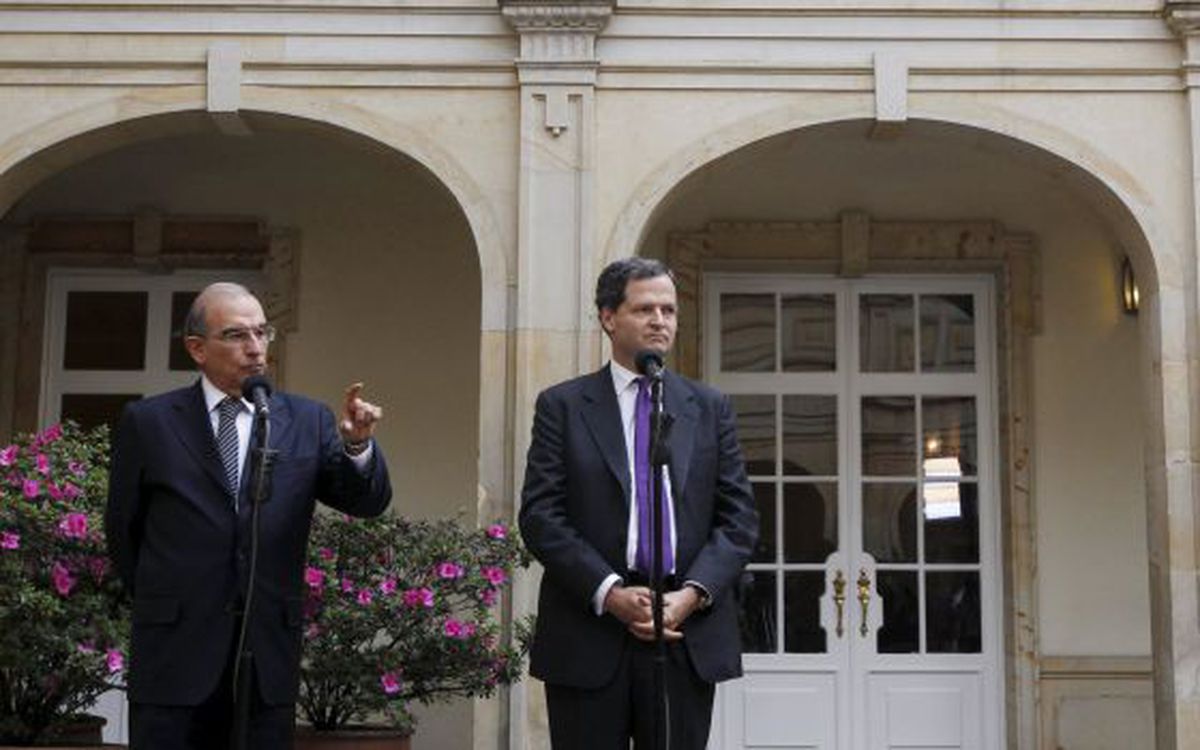 Humberto de la Calle and Sergio Jaramillo, in a file, at the Casa de Nariño in Bogotá JOHN VIZCAINO
Humberto de la Calle and Sergio Jaramillo, in a file, at the Casa de Nariño in Bogotá JOHN VIZCAINO
Gustavo Petro wants peace and quiet. The Colombian President convened Juan Manuel Santos’ government negotiators with the FARC and his own, who are in dialogue with the ELN, in Cartagena de Indias next week to smooth things over, government sources confirmed to EL PAÍS. The former openly criticized the latter last week for giving in too much to the country’s last armed guerrillas, who are not on good terms with the government. Now they have the opportunity to reconcile and share experiences.
Among others, Humberto de la Calle, Sergio Jaramillo, María Ángela Holguín and the Spaniard Enrique Santiago have been invited to the event. The list was agreed between Petro and Santos, who met at the Casa de Nariño, the president’s residence, on Wednesday. After the hiatus that marked Iván Duque’s four-year tenure, the discussion about the search for peace has returned to settle in the public debate because of total peace, with which Petro wants to be more determined to implement the agreement with the defunct FARC, dialogue with of the ELN and at least part of the disagreements and a policy of submission to other criminal groups, such as the Clan del Golfo, with whom they have just suspended the truce.
The two main architects of the talks in Havana have made no secret of their objections to some aspects of total peace, particularly the new agenda agreed at the table with the ELN and announced by Mexico this month. The ELN is “shooting all the gates” in the government, opening the door to “an endless negotiation,” warned Santos’ peace commissioner Jaramillo, while now-Senator De la Calle, then chief negotiator, said the “spongy language.” on neuralgic topics such as laying down weapons.
At the end of the Santos government (2010-2018), the agenda was agreed with the National Liberation Army, which was succeeded by Duque (2018-2022), a staunch critic of the deal with the FARC. Duque ended this other trial after the January 2019 attack on a police academy in Bogotá that killed 23 people. From the start of his tenure, Petro had proposed resuming talks with the ELN at the same point they were suspended.
That original agenda was on the table until this month, when government and guerrilla delegations kicked off the second cycle in Mexico City with the announcement of a New agenda the peace dialogues. While the guerrillas did not want to recognize Colombia as a social constitutional state, the state gave it the character of a “military-political organization of the rebels”. “There is no evidence that the guerrillas are willing to end the conflict,” said Jaramillo from Brussels in an interview with W radio. “It is true that the Petro government inherited a general ambiguous agenda, but it seems to me that those ambiguities that were on the agenda were all resolved in favor of the ELN,” he said. In its interpretation, this roadmap intends to review Colombia’s economic model and political regime, more like the failed negotiations in Caguan in the government of Andrés Pastrana (1998-2002) than the Havana dialogues.
Jaramillo’s criticism was joined by De La Calle, who questioned cattle leader José Felix Lafaurie, a representative of the far-right sectors who Petro included in his negotiating team: “Why did you unleash unrelenting opposition to the process with the FARC? , when there are much more compromising issues for state and society in the current agenda with the ELN? Both had already written in a joint letter last December to the Petro government, calling on the implementation, which had stalled during the Duque period, to put words into action, “so that the peace process in the areas of Colombia does not gain further ground loses”. .
Newsletter
Current affairs analysis and the best stories from Colombia, delivered to your inbox every week
GET THIS
The friction didn’t end there. “Foolish words fall on deaf ears,” replied Foreign Minister Álvaro Leyva, who advised the FARC at the Havana talks. “It was necessary to change the plan of a senior peace commissioner yesterday. Being smart to show off is like being a Monday morning football commentator. Dead easy. The best contribution to peace is to build, not destroy,” he wrote on his social media. “There are no masters of peace here, and no wise haruspices in such a delicate matter,” he later added.
In many regions, the war that deals with the FARC sought to quench still rages, humanitarian challenges persist and violence has increased. There are seven non-international armed conflicts between different actors, according to the annual report presented by the International Committee of the Red Cross (ICRC) this week in Bogotá. Three of them stand between the government and some armed actors: the ELN, the Clan del Golfo and the FARC dissidents. The other four are between the ELN and the Clan del Golfo, in addition to those that confront these dissident structures with two other factions that consider themselves heirs to the FARC: the Segunda Marquetalia and the Border Commandos.
Subscribe here to the EL PAÍS newsletter on Colombia and receive all the latest information about the country.

